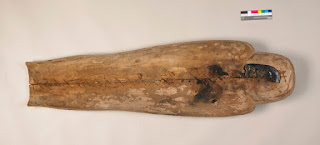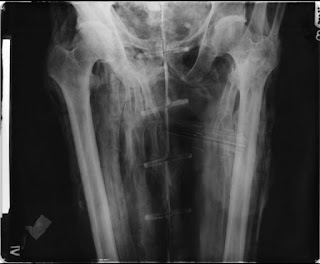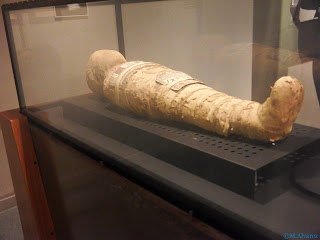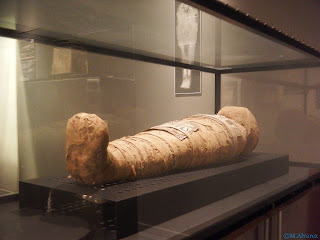Giovanni Marro in laboratorio mentre analizza una mummia egizia proveniente dagli scavi della Missione Archeologica Italiana in Egitto (1911-1936).
museoantropologia.unito.it/index.php
martes, 28 de noviembre de 2017
domingo, 26 de noviembre de 2017
Máscara de momia
Máscara de momia
Museo de Monserrat
inv. 620.208
...
Museo de Monserrat
inv. 620.208
...
p-grecorromano
27 X 195 cms.
Máscara de madera doradas hecha con cartonaje con inscripción en jeroglíficos en la parte superior.
Los rasgos faciales del difunto aparecen representados com cierto nivel de realismo: los labios son carnosos, la nariz recta y afilada, y el mentón prominente.
27 X 195 cms.
Máscara de madera doradas hecha con cartonaje con inscripción en jeroglíficos en la parte superior.
Los rasgos faciales del difunto aparecen representados com cierto nivel de realismo: los labios son carnosos, la nariz recta y afilada, y el mentón prominente.
lunes, 20 de noviembre de 2017
domingo, 3 de septiembre de 2017
Naqada III
Photograph of a Naqada III grave, from
the Fort Cemetery, Tomb 32, at Hierakonpolis of an adult woman. Greater
than usual number of burial goods in the grave (originally 20 jars and
bowls) she must have hade high status in the community. She also had a
large palette and the raw materials needs to produce eye paint; and she
wore a string of beads.
http://www.ancient-egypt.co.uk/metropolitan/pages/Metropolitan%20NY%20Nov-2005%200044.htm
http://www.ancient-egypt.co.uk/metropolitan/pages/Metropolitan%20NY%20Nov-2005%200044.htm
sábado, 2 de septiembre de 2017
miércoles, 31 de mayo de 2017
jueves, 11 de mayo de 2017
mummy
This extremely well preserved mummy is that of a man who lived during the Ptolemaic Period. According to the customs of the time, the body of the deceased was carefully wrapped in strips of linen; the design formed by these strips, notably around the face, was often extremely sophisticated. The mummy is covered with a cartonnage consisting of several elements: a mask covering the head, a wide collar over the chest, an apron across the legs, and finally, a casing over the feet.
Louvre Museum
Louvre Museum
miércoles, 10 de mayo de 2017
Human Remains; Mummy of Padiamun
Human Remains; Mummy of Padiamun
Mummified remains of a male adult named Padiamun, an official of the barque of Amun at Karnak who lived in the late 8th century BC. His name means 'he whom Amun gave' and he held the titles 'sailor of the barque of Amun' and 'chief of navigation of the barque of Amun'. Inscriptions on his coffins reveal his father was Thatienwensu and his mother was Taditanebhen. His brother was Nehemsumontu who was also a 'chief of navigation of the barque of Amun' and his coffins are now in museums at Boulogne-sur-Mer and Grenoble.
In September 1851 Padiamun’s mummy was unwrapped at Edgeworth Manor by a surgeon named H W Rumsey, Esq. The wrappings were roughly replaced after the examination in 1851 and then rewrapped in 1976. There are several bags of excess bandages. The mummy was X-rayed in 1967 and CT scanned in 2012 . PHK Gray who led the radiograph study of Liverpool's mummies in 1967 noted that the treatment of Padiamun's body is not normally found after the beginning of the Twenty-sixth Dynasty and suggested embalmment during the Twenty-first and Twenty-second Dynasties. A sample of resin was taken from the top of the cranium in 1999 for analysis which revealed the contents to be: 61% fat/oil, 0.2% coniferous resin, 1.5% balsam
...........
http://www.liverpoolmuseums.org.uk/wml/collections/antiquities/ancient-egypt/item-303546.aspx
viernes, 7 de abril de 2017
Examinations of a baby boy mummy
Examinations of a baby boy mummy
I think it’s about time we introduce you to a special occupant of the Artifact Lab.
This baby boy mummy, who dates to the Third Intermediate Period (1075-656 BCE), has been in our collection since 1898, when he was donated to the museum by Dr. Henry Shurtleff.
This baby boy mummy, who dates to the Third Intermediate Period (1075-656 BCE), has been in our collection since 1898, when he was donated to the museum by Dr. Henry Shurtleff.
It seems that this mummy came into the collection unwrapped – he only has small amounts of textile preserved on his body (and there is currently no evidence that the cloth partially covering his body in the image above is related to his remains, but this remains to be determined). While the fact that he is unwrapped is unfortunate, it allows us to see how well preserved his remains are and evidence of how his body was mummified, including evisceration through an incision on the left side of his torso.
A CT scan in 2009 further reveals how this boy’s body was mummified, and also reveals damage not visible from the exterior. For example, it is clear that his brain was removed, likely through the nose (but due to the small side of his nasal bones it is not possible to see evidence of this). The scan also reveals a large hole in the left lower side of his skull, and the piece of missing bone resting inside his skull.
The excellent preservation of his body is not the only remarkable thing about this baby boy. While examining his remains, we noticed traces of a green substance in areas, including on his face and fingers.
This substance resembles copper corrosion, and it may either be corrosion from copper that was once in contact with his body (during burial), or may be traces of a green copper-based pigment. How do we know this green substance is copper-based? We tested it with our portable x-ray fluorescence analyzer, which showed high peaks for copper in these areas.
While we’re still working to interpret some of this information, I can tell you one thing for certain: this baby boy mummy sure is special. And if you visit the lab, you just might catch a glimpse of him.
https://www.penn.museum/…/03/examinations-of-a-baby-boy-mu…/
Ver másThe excellent preservation of his body is not the only remarkable thing about this baby boy. While examining his remains, we noticed traces of a green substance in areas, including on his face and fingers.
This substance resembles copper corrosion, and it may either be corrosion from copper that was once in contact with his body (during burial), or may be traces of a green copper-based pigment. How do we know this green substance is copper-based? We tested it with our portable x-ray fluorescence analyzer, which showed high peaks for copper in these areas.
While we’re still working to interpret some of this information, I can tell you one thing for certain: this baby boy mummy sure is special. And if you visit the lab, you just might catch a glimpse of him.
https://www.penn.museum/…/03/examinations-of-a-baby-boy-mu…/
Left: A detail of the green substance under the boy’s right eye. Right: An overall view of the boy’s face, highlighting the locations of the green substance in a brighter green color.
The open fontanelle on the top of the baby’s head is indicated in these 2 images with blue arrow
Two CT still images show the child mummy’s skull with a piece of bone resting inside the cranium (left) and the hole created as a result of this loss (right
The open incision on the left side of his body reveals a mostly empty body cavity, containing small bundles of linen.
sábado, 18 de marzo de 2017
domingo, 12 de marzo de 2017
viernes, 10 de marzo de 2017
mummy
Mummy dating from the Greco-Roman period, from Thebes, belonging to the so-called "Marquess Busca's mummy" in the Egyptian Museum in the Castello sforzesco in Milan, Italy. This is a pastiche/hoax created at the beginning of 19th century by Egyptian clandestine atnique dealers for roma marquess Carlo Busca. They created a "compete" sarcophagus by using the cover of the sarcophagus once beloged to a Pa-di-Khonsu (XX/XXIV dinasty, 9th century BC), the sarcophagus once beloged to a Di-Hor-Khapet (XXV/XXVII dinasty, 7th/6th century BC), a mummy from the Greco-Roman period, and the papyrus scroll of a Book of the Dead by scribe Pthames (15th century BC). - Picture by Giovanni Dall'Orto, February 14 2008.
viernes, 17 de febrero de 2017
Young crocodiles, mummied
Peabody Number: 78-64-50/16528.1
Descriptions:
Inventory Description: Organic, fabric wrapped mummified reptiles
Classification:
Mummy
Department:
Archaeological
Geography/Provenience:
Africa/Egypt
Materials: Fiber, Bone, Hide
Dimensions: Overall: 18.1 x 2.8 x 3.8 cm (7 1/8 x 1 1/8 x 1 1/2 in.) Overall, Weight: 12.3 g (0.012 kg)
Provenance:
Donor: Clarence Bloomfield Moore (01/01/1878)
Collector: Clarence Bloomfield Moore (Unknown)
http://pmem.unix.fas.harvard.edu:8080/peabody/view/objects/asitem/search$0040/0/title-desc?t:state:flow=8344c201-5831-4b1a-a4fc-b7fa72562f7d
miércoles, 15 de febrero de 2017
Mummy
An upper-class Egyptian male, often referred as "Usermontu"
Mummy of an upper-class Egyptian male from the Saite period.
Rosicrucian Egyptian Museum
Suscribirse a:
Comentarios (Atom)

















































